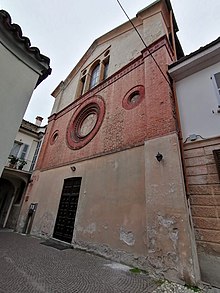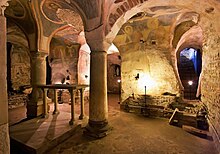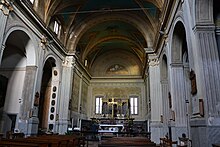
Rothari, of the house of Arodus, was king of the Lombards from 636 to 652; previously he had been duke of Brescia. He succeeded Arioald, who was an Arian like himself, and was one of the most energetic of Lombard kings. Fredegar relates that at the beginning of his reign he put to death many insubordinate nobles, and that in his efforts for peace he maintained very strict discipline.

The Certosa di Pavia is a monastery and complex in Lombardy, Northern Italy, situated near a small town of the same name in the Province of Pavia, 8 km (5.0 mi) north of Pavia. Built in 1396–1495, it was once located on the border of a large hunting park belonging to the Visconti family of Milan, of which today only scattered parts remain. It is one of the largest monasteries in Italy.

Santa Maria del Carmine is a church in Pavia, Lombardy, northern Italy, considered amongst the best examples of Lombard Gothic architecture. It was begun in 1374 by Gian Galeazzo Visconti, Duke of Milan, on a project attributed to Bernardo da Venezia. The construction followed a slow pace, and was restarted in 1432, being finished in 1461.

Santa Maria di Canepanova is a Renaissance style Roman Catholic church located in central Pavia, region of Lombardy, Italy. Although in the past the design was popularly attributed to Bramante, the church was designed by Giovanni Antonio Amadeo.

Pavia Cathedral is a church in Pavia, Italy, the largest in the city and seat of the Diocese of Pavia. The construction was begun in the 15th century on the site of two pre-existing Romanesque, "twin" cathedrals. The cathedral houses the remains of St. Sirus, first Bishop of Pavia, and a thorn purported to be from the Crown of Thorns worn by Christ. The marble facing of the exterior was never completed.
Gundeberga or Gundeperga,, was queen of the Lombards in 626-652 by marriage to the kings Arioald, (king of the Lombards; 626-636) and his successor Rothari, (king of the Lombards; 636-652). She acted as Regent during the minority of her son Rodoald after the death of her second husband in 652.

The Civic Museums of Pavia are a number of museums in Pavia, Lombardy, northern Italy. They are housed in the Castello Visconteo, or Visconti Castle, built in 1360 by Galeazzo II Visconti, soon after taking the city, a free city-state until then. The credited architect is Bartolino da Novara. The castle used to be the main residence of the Visconti family, while the political capital of the state was Milan. North of the castle a wide park was enclosed, also including the Certosa of Pavia, founded 1396 according to a vow of Gian Galeazzo Visconti, meant to be a sort of private chapel of the Visconti dynasty. The Battle of Pavia (1525), climax of the Italian Wars, took place inside the castle park.
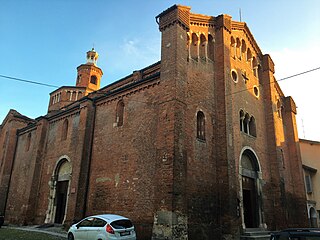
San Teodoro is a Romanesque-style Roman Catholic church in the town center of Pavia, Italy.

Santi Primo e Feliciano is a Romanesque-style Roman Catholic church in the town center of Pavia, Italy.

San Lanfranco is a Romanesque-style Roman Catholic church and former abbey, located on via San Lanfranco Vescovo, 4/6, just west of the town center of Pavia, region of Lombardy, Italy.

The church of San Francesco of Assisi is a Catholic religious building in Pavia, Lombardy, Italy.

The church of Sant'Eusebio was a church of Pavia, of which today only the crypt remains. The church was probably built by the Lombard king Rothari (636-652) as the city's Arian cathedral. It later became the fulcrum of the conversion to Catholicism of the Lombards initiated by Theodolinda and the monks of San Colombano and which later received, precisely in Pavia, a great impulse from King Aripert I (653-661) and from Bishop Anastasius.

The Basilica of Santissimo Salvatore is a Roman Catholic church in Pavia, region of Lombardy, Italy. It was founded in 657 by the Lombard king Aripert I and became a mausoleum for many of the Lombard kings.

The church of Santa Maria in Betlem, founded around 1130, stands in the characteristic district of the Borgo of Pavia, located, after the Ponte Coperto, on the other bank of the Ticino river from the city center.

The monastery of San Felice was one of the main female Benedictine monasteries of Pavia; founded since the Lombard period, it was suppressed in the 18th century.Part of the church and the crypt survive from the original Lombard complex.

The church of San Marino is a Catholic church in Pavia, in Lombardy.

The Church of San Tommaso is a former Catholic church and monastery in the city of Pavia, Lombardy, Italy. It is located within the historic city center and belongs to the University of Pavia.

The monastery of Santa Maria Teodote, also known as Santa Maria della Pusterla, was one of the oldest and most important female monasteries in Pavia, Lombardy, now Italy. Founded in the seventh century, it stood in the place where the diocesan seminary is located and was suppressed in the eighteenth century.
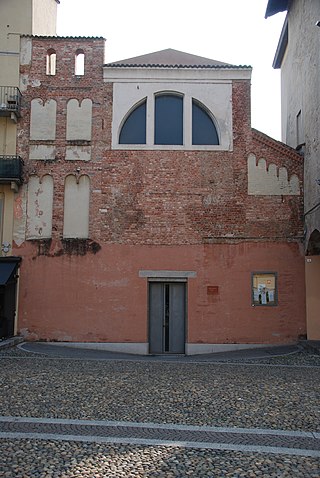
The church Santa Maria Gualtieri is a deconsecrated church in Pavia now used for exhibitions, concerts and conferences.
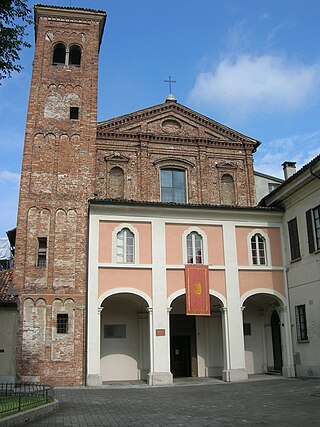
The Church of Santi Gervasio e Protasio is a church in Pavia, in Lombardy.
